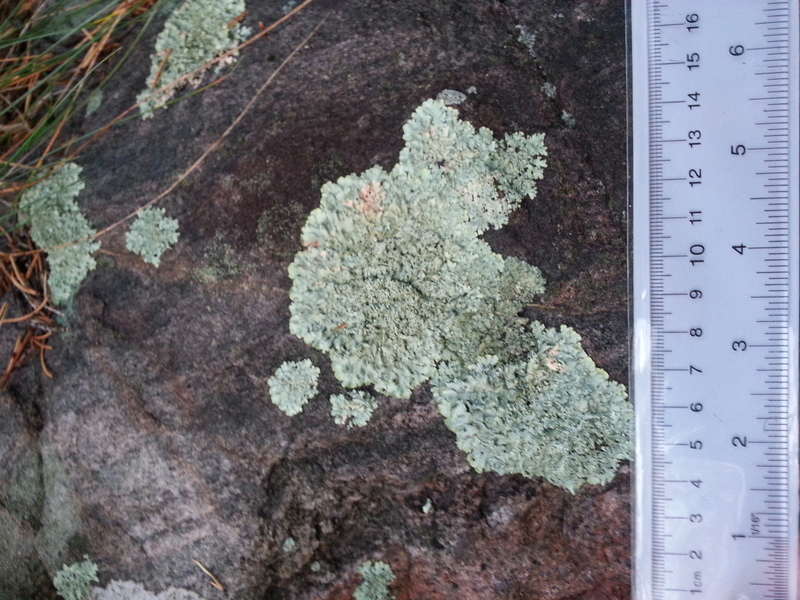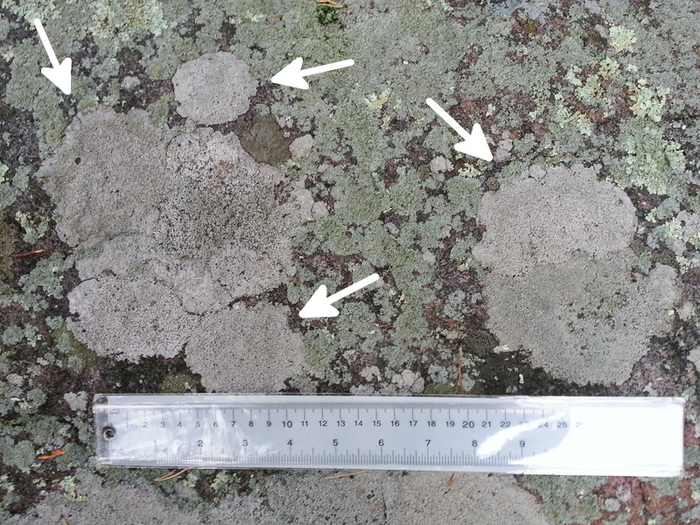Some exciting recent news about moss and lichen.
Early moss is responsible for the oxygen that led to all the life around us. The Guardian covers the story in All hail the humble moss, bringer of oxygen and life to Earth:
Around 445 million years ago most the planet’s terrestrial landscape was being assembled by plate tectonics into a southern hemisphere supercontinent called Pangaea. What is now the Appalachians in the US were arcs of rock in the tropic ocean. The northern hemisphere was almost entirely ocean and almost all life was concentrated in the sea.
The bony fishes had yet to evolve. Trilobites patrolled what was then essentially Waterworld. Whatever life clung to the exposed rocks in what geologists call the Ordovician period would have been little more than a fine mat of microbes.
Rock-hugging green mosses evolved, and spread over dry land, using photosynthesis to take atmospheric oxygen from perhaps only a quarter of today’s level to the present life-giving lungful.

The research article reported on is Earliest land plants created modern levels of atmospheric oxygen by Lenton et al. in Proceedings of the National Academy of Sciences of the United States of America (PNAS) in some online prepublication thing I can’t cite properly. It’s not open access so most of the world can’t see it. Disappointing. Ask your nearest librarian. Here’s the abstract:
The progressive oxygenation of the Earth’s atmosphere was pivotal to the evolution of life, but the puzzle of when and how atmospheric oxygen (O₂) first approached modern levels (∼21%) remains unresolved. Redox proxy data indicate the deep oceans were oxygenated during 435–392 Ma, and the appearance of fossil charcoal indicates O₂ > 15–17% by 420–400 Ma. However, existing models have failed to predict oxygenation at this time. Here we show that the earliest plants, which colonized the land surface from ~470 Ma onward, were responsible for this mid-Paleozoic oxygenation event, through greatly increasing global organic carbon burial—the net long-term source of O₂. We use a trait-based ecophysiological model to predict that cryptogamic vegetation cover could have achieved ∼30% of today’s global terrestrial net primary productivity by ∼445 Ma. Data from modern bryophytes suggests this plentiful early plant material had a much higher molar C:P ratio (∼2,000) than marine biomass (∼100), such that a given weathering flux of phosphorus could support more organic carbon burial. Furthermore, recent experiments suggest that early plants selectively increased the flux of phosphorus (relative to alkalinity) weathered from rocks. Combining these effects in a model of long-term biogeochemical cycling, we reproduce a sustained +2‰ increase in the carbonate carbon isotope (δ¹³C) record by ∼445 Ma, and predict a corresponding rise in O₂ to present levels by 420–400 Ma, consistent with geochemical data. This oxygen rise represents a permanent shift in regulatory regime to one where fire-mediated negative feedbacks stabilize high O₂ levels.
This is great research, but it pales compared to the recent lichen news, which completely overturned our understanding of this strange life form. ScienceNews gives popular coverage in Yeasts hide in many lichen partnerships:
The discovery of unknown yeasts hiding in lichens from six continents could shake up a basic idea of what makes up a lichen partnership.
For more than a century, biologists have described a lichen as a fungus growing intimately with some microbes (algae and/or cyanobacteria) that harvest solar energy. The fungus is treated as so important that its name serves as the name for the whole lichen.
Biologists have recognized that more than one fungus can show up in lichen close-ups, but their role hasn’t been clear. Now that may be on the brink of changing.
Fifty-two genera of lichens collected from around the world include a second fungus — single cells, called yeasts, of a previously unknown order now christened Cyphobasidiales. Toby Spribille of the University of Graz in Austria and colleagues report the finding online July 21 in Science.

Here’s more from a story out of Purdue, where one of the lead researchers is: Yeast emerges as hidden third partner in lichen symbiosis:
Scientists have long recognized the fundamental partnership that produces lichens: A fungus joins with an alga or cyanobacteria in a relationship that benefits both individuals. In a study led by the University of Montana and co-authored by Purdue mycologist M. Catherine Aime, researchers show that lichens across six continents also contain basidiomycete yeasts, single-celled fungi that likely produce chemicals that help lichens ward off predators and repel microbes.
The finding could explain why many genetically similar lichens present wildly different physical features and why scientists have been unable to synthesize lichens in the laboratory, even when combining species that partner successfully in nature.
For something like 150 years, as I understand it, we thought lichen was a kind of sandwich with a fungus on the outside and an algae or cyanobacteria on the inside eating sunlight and providing the food. That’s crazy enough—and the things are all over rocks and trees all around you, just go out and look—the stuff can look about as close to living mineral as you can imagine—but now it turns out there’s yeast in there and no one knew.

The article is here (also not open): Basidiomycete yeasts in the cortex of ascomycete macrolichens by Spribille et al. in Science 353:6298 (29 July 2016). Abstract:
For over 140 years, lichens have been regarded as a symbiosis between a single fungus, usually an ascomycete, and a photosynthesizing partner. Other fungi have long been known to occur as occasional parasites or endophytes, but the one lichen–one fungus paradigm has seldom been questioned. Here we show that many common lichens are composed of the known ascomycete, the photosynthesizing partner, and, unexpectedly, specific basidiomycete yeasts. These yeasts are embedded in the cortex, and their abundance correlates with previously unexplained variations in phenotype. Basidiomycete lineages maintain close associations with specific lichen species over large geographical distances and have been found on six continents. The structurally important lichen cortex, long treated as a zone of differentiated ascomycete cells, appears to consistently contain two unrelated fungi.
It’s exciting, sure, when scientists discover a nearby exoplanet or yet another hominid species that interbred with us tens of thousands of years ago, but when they find out there’s something going on in lichen—which is probably on the sidewalk or wall outside where you are right now—that is totally unexpected, well, that’s exciting too.
 Miskatonic University Press
Miskatonic University Press